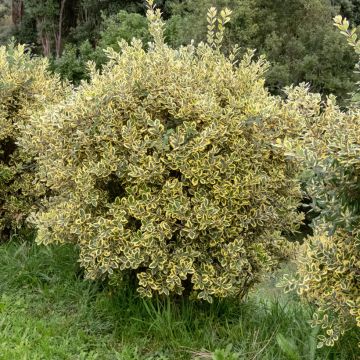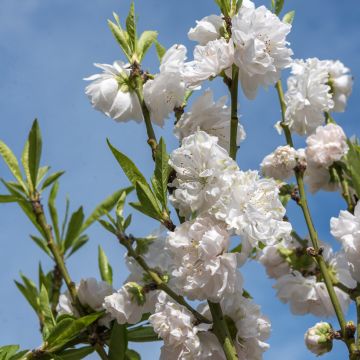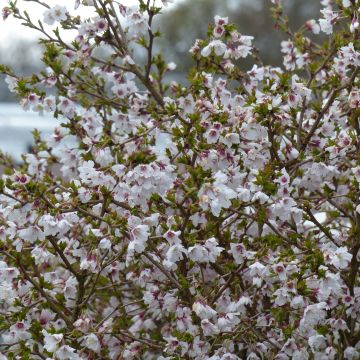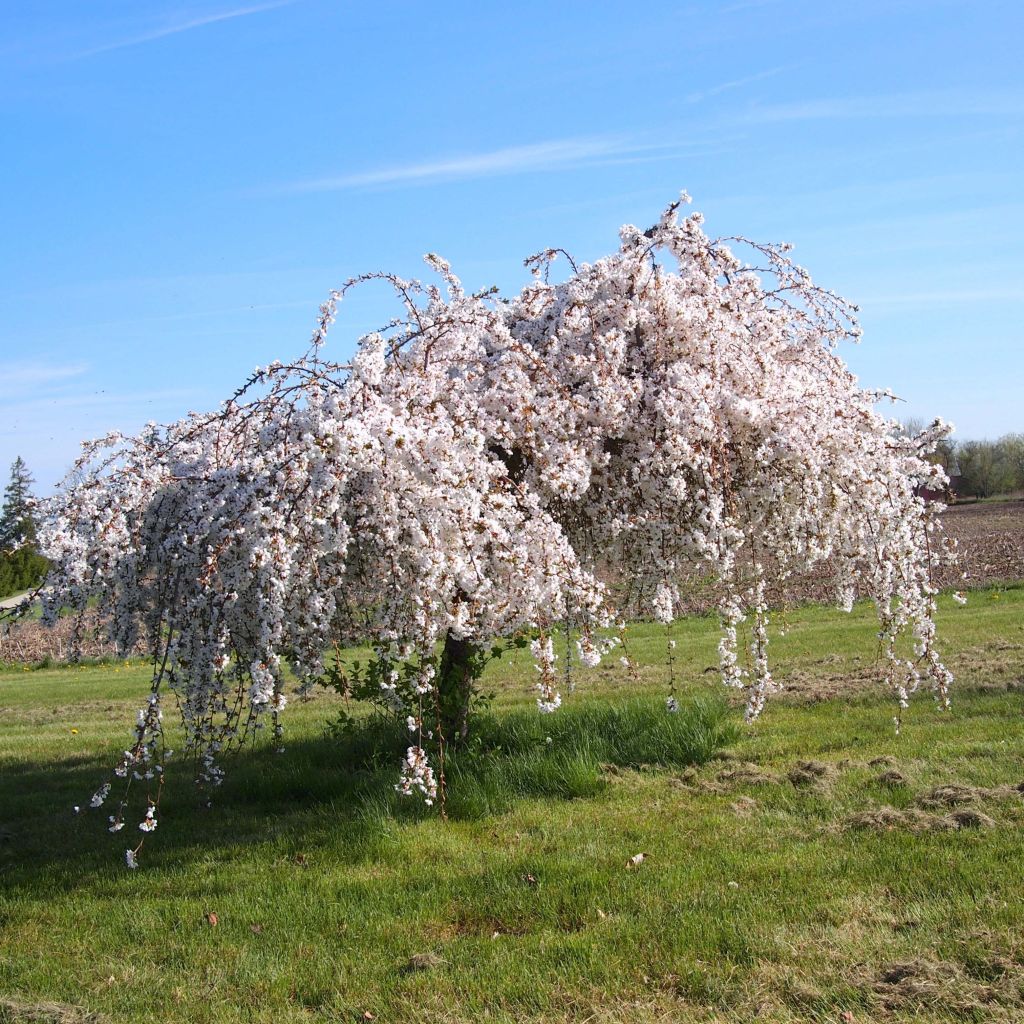

Prunus Snow Fountains - Cherry


Prunus Snow Fountains - Cherry


Prunus Snow Fountains - Cherry
Prunus Snow Fountains - Cherry
Prunus Snow Fountains® 'Snofozam'
Cherry, Plum, Peach, Apricot, Almond
Sublime young plant pour enjoliver ma terrasse, j'ai hâte qu'elle grandisse.
Liyin, 18/03/2023
Why not try an alternative variety in stock?
View all →This plant carries a 24 months recovery warranty
More information
We guarantee the quality of our plants for a full growing cycle, and will replace at our expense any plant that fails to recover under normal climatic and planting conditions.
From €7.90 for pickup delivery and €6.90 for home delivery
Express home delivery from €8.90.
Does this plant fit my garden?
Set up your Plantfit profile →
Description
The Prunus 'Snow Fountains' is an American variety of flowering cherry tree that forms a charming small tree with a regular weeping habit, carrying long, flexible branches that cascade down to touch the ground. From the month of May, an abundance of pendant clusters of delicate pure white flowers adorn the entire naked branches, like a shower of snow! Small leaves turn yellow and orange, heralding the arrival of autumn. Hardy and requiring no pruning, it is the perfect choice for a small garden as long as it enjoys plenty of sunlight and a normal to rich, not too dry and well-drained soil.
The 'Snow Fountains' cultivar, developed in 1985 by Lake County Nursery in the USA, shows particularly reduced growth, well suited for container cultivation. At maturity, it will not exceed 3m (9 ft 10 in) in all directions. With a naturally weeping habit, it develops a straight, tall trunk and trailing branches. Flowering occurs very early in spring, sometimes as early as March in the south of our country. In average climates, it generally takes place in April. The flowers, produced abundantly, open before the leaves, suspended by a short peduncle on well-defined branches. They emerge from white buds and then bloom into simple, bell-shaped, white corollas with no trace of pink. This flowering attracts pollinating insects that transform the flowers into small reddish cherries, sought after by birds but not edible for humans. The deciduous foliage consists of alternate leaves, 3 to 6 cm (1.2 to 2.4 in) long, ovate in shape, finely and deeply toothed along the edges. They are dark green in summer before turning yellow-orange in autumn.
This small tree, a symbol of renewal, is suitable for small gardens and can be planted in beds or as a standalone specimen, in free-standing hedges, and also in rows. 'Snow Fountains', not demanding, is content with a well-prepared ordinary soil, tolerates heat and the presence of limestone in the soil without excess. It can be grown in most of our regions, from north to south. For example, in a hedge or bed, it can be combined with other spring-flowering shrubs, simultaneously or staggered, such as Japanese apricot trees (Prunus mume), ornamental apple trees, Japanese quinces, flowering peach trees, Chinese almond trees, hawthorns... It naturally finds its place in a Japanese garden, in a sunny position.
Prunus Snow Fountains - Cherry in pictures


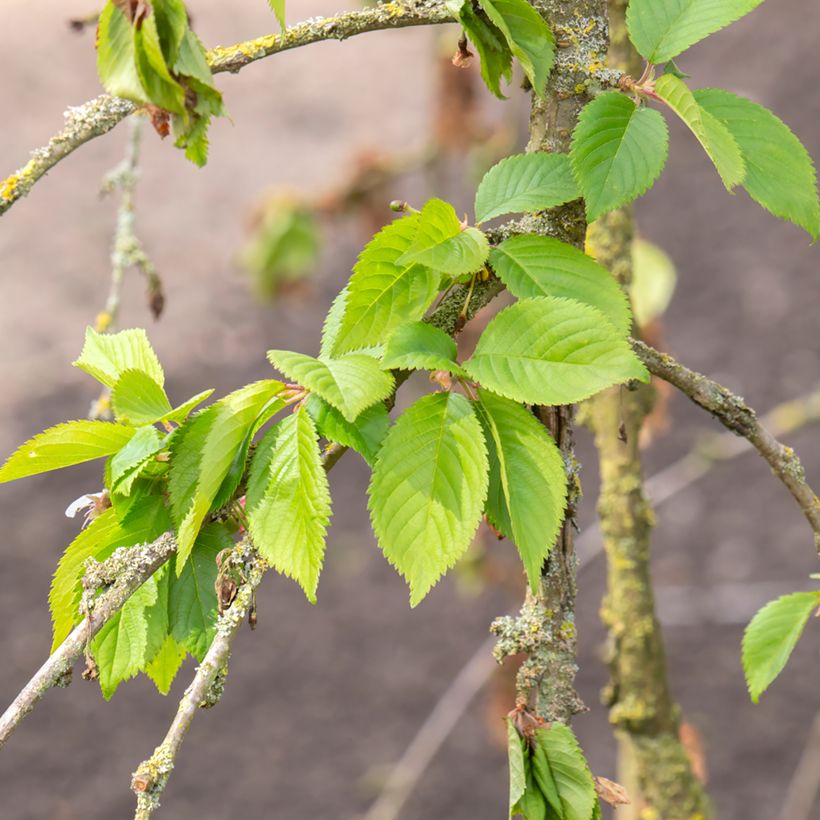



Plant habit
Flowering
Foliage
Botanical data
Prunus
Snow Fountains® 'Snofozam'
Rosaceae
Cherry, Plum, Peach, Apricot, Almond
Cultivar or hybrid
Other Prunus
View all →Planting and care
The Prunus incisa 'Snow Fountains' thrives in full sun in any soil that is fairly rich, moist but well-drained, neither too acidic nor too alkaline, and not excessively wet or dry. Water during abnormally dry and hot weather. When planting, mix your soil with compost at a ratio of 50%. Dig a large planting hole. Apply a flowering shrub fertilizer every spring. Be cautious of late frosts that could damage early flowering. This is why it is preferable to place the prunus in a somewhat sheltered spot from dry and cold winds.
Planting period
Intended location
Care
Trees for small gardens
Haven't found what you were looking for?
Hardiness is the lowest winter temperature a plant can endure without suffering serious damage or even dying. However, hardiness is affected by location (a sheltered area, such as a patio), protection (winter cover) and soil type (hardiness is improved by well-drained soil).

Photo Sharing Terms & Conditions
In order to encourage gardeners to interact and share their experiences, Promesse de fleurs offers various media enabling content to be uploaded onto its Site - in particular via the ‘Photo sharing’ module.
The User agrees to refrain from:
- Posting any content that is illegal, prejudicial, insulting, racist, inciteful to hatred, revisionist, contrary to public decency, that infringes on privacy or on the privacy rights of third parties, in particular the publicity rights of persons and goods, intellectual property rights, or the right to privacy.
- Submitting content on behalf of a third party;
- Impersonate the identity of a third party and/or publish any personal information about a third party;
In general, the User undertakes to refrain from any unethical behaviour.
All Content (in particular text, comments, files, images, photos, videos, creative works, etc.), which may be subject to property or intellectual property rights, image or other private rights, shall remain the property of the User, subject to the limited rights granted by the terms of the licence granted by Promesse de fleurs as stated below. Users are at liberty to publish or not to publish such Content on the Site, notably via the ‘Photo Sharing’ facility, and accept that this Content shall be made public and freely accessible, notably on the Internet.
Users further acknowledge, undertake to have ,and guarantee that they hold all necessary rights and permissions to publish such material on the Site, in particular with regard to the legislation in force pertaining to any privacy, property, intellectual property, image, or contractual rights, or rights of any other nature. By publishing such Content on the Site, Users acknowledge accepting full liability as publishers of the Content within the meaning of the law, and grant Promesse de fleurs, free of charge, an inclusive, worldwide licence for the said Content for the entire duration of its publication, including all reproduction, representation, up/downloading, displaying, performing, transmission, and storage rights.
Users also grant permission for their name to be linked to the Content and accept that this link may not always be made available.
By engaging in posting material, Users consent to their Content becoming automatically accessible on the Internet, in particular on other sites and/or blogs and/or web pages of the Promesse de fleurs site, including in particular social pages and the Promesse de fleurs catalogue.
Users may secure the removal of entrusted content free of charge by issuing a simple request via our contact form.



































